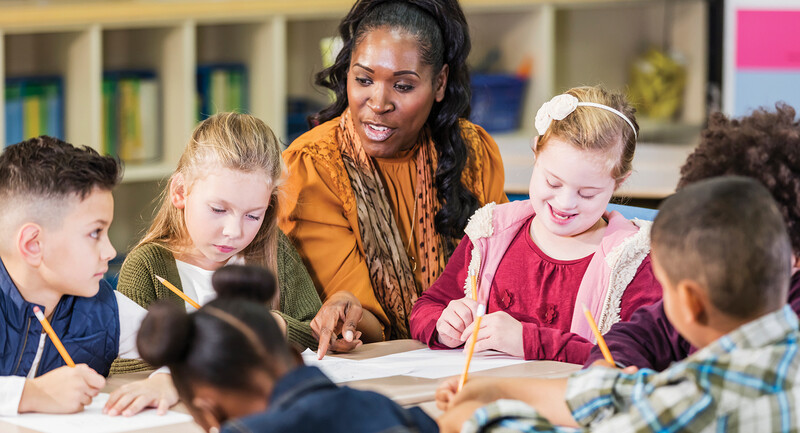February 1, 2022
•
•
Vol. 79•
No. 5Making Equity Audits Matter
Audits can help you see inequities your school may be "swimming in."
Credit: Copyright (c) 2019 fizkes/Shutterstock. No use without permission.
They say a fish doesn't notice the water it swims in. The context of our professional lives is so all-encompassing, we often overlook what's right in front of us. Equity requires that schools pose questions to themselves—starting from the assumption that inequities, like water, surround us—and identify barriers that restrict students' aspirations. An equity audit helps us do so.
Health Sciences High and Middle College in San Diego, where we work, undergoes an annual building equity audit to help our school notice obstacles to student opportunity by interrogating conditions we might otherwise accept unquestioningly. We designed this audit in 2017 when our colleagues Ian Pumpian and Dominique Smith challenged prevailing assumptions about access and outcomes. In many cases, they noted, an equity plan looks only at access to educational opportunities, without defining the desired outcomes. Other plans focus on raising achievement levels for certain groups (outcomes) but don't identify actions for eliminating persistent discrepancies between groups. Shouldn't equity planning begin with an audit that's access- and outcome-oriented?
Starting with this question, the four of us developed an audit featuring a taxonomy for equity that points to needed actions for improvement (see fig. 1). Excellence for everyone emerges through successive processes, each assessing and supporting the next level of equity. In other words, a school won't achieve instructional excellence without first establishing opportunities to learn, social-emotional engagement, and physical integration. Each level includes a survey for students and one for staff to measure how a school is doing on this process.
We can all describe students we've known who fit the bill of engaged and empowered students. Their leadership skills, academic prowess, or community engagement remind us of the rewards of working with young people. But too often, such students are the exception. Many high schools have a senior class that's troublingly smaller than its 9th grade class. Some kindergarten students miss 10 or more days of school. Disengaged kids signal failures at a systems level.
Empowered learners take ownership of their learning by embracing curricular leadership, since school adults give them a voice in what's taught and how they learn. They co-construct essential questions and success criteria with teachers and provide feedback about their learning. Such students are, intentionally, taught about how they learn, not just what to learn. Their schools foster their aspirations through programs, but also through chances to explore service learning in the community.
The quality of instruction in a school has direct bearing on the school's ability to produce an empowered student body. Having high-quality core instruction for all students requires teachers to adhere to a well-articulated instructional framework.
Compensatory and adaptive practices must be firmly in place at a systems level, not as a one-off for individual students. In any school, some youth will need supplemental or intensive interventions—like tutoring or academic recovery services—to compensate for learning gaps. And every school has students who qualify for adaptive supports. Offering such supports successfully requires that special and general educators have collaborative planning time, and that PD amplifies the school's efforts to develop all these dimensions of instructional excellence.
Instructional excellence is a shallow victory if it's not experienced by every student in the building. The opportunity to learn concept is well understood in the equity literature as being a fulcrum for excellence. To ensure all have this opportunity, at the high school level, analyze transcripts to see the pathways of students who graduated with advanced vs. general diplomas and identify key points of divergence. At the elementary level, examine processes used to create class rosters or make retention decisions.
The human capital of any group of students (cognitive and interpersonal skills) is highly predictive of their academic results. Learners tracked into remedial programs often miss out on developing interpersonal skills like perspective taking because they rarely work with a broad range of peers; their opportunity to learn is diminished (ditto for those tracked into advanced course work). Leaders should close gaps that disproportionately weaken students' social capital, their network of relationships. For example, a lack of translation services at an elementary information night could result in families who don't speak English missing the opportunity to enroll their children in enrichment programs.
A school that lacks the cultural proficiency to fully engage with students and families cannot advance the assets-based approach to learning essential to equity. Schools that proactively seek to learn from and cultivate meaningful partnerships are better equipped to foster engaged and inspired learners. Families shouldn't hear from the school only when there's a problem.
A restorative practices lens on discipline—shifting the focus to repairing relationships—increases opportunities to learn (since kids learn little when suspended or absent). After 15 years at a school invested in restorative practices, we can tell you that using such practices requires continuous investment in the adults at the school—but strengthens everyone's SEL skills.
This is foundational: A school community that excludes some students can never achieve its full potential. One example of a group that's frequently not included, instead routinely served in segregated settings, is students with disabilities. An audit helps one examine the master schedule and take note of the race, ethnicity, and gender distributions of students in different courses. Do you notice that a particular type of student is conspicuously not present—so physically excluded—in certain "tracks"?
In the accompanying video, you'll hear the voices of HSHMC students and staff sharing questions that Sonja Hollins-Alexander and Nicole Law (who consult with our school) say an equity audit should challenge a school community to answer. A good equity audit raises questions the school needs to confront, yielding answers rarely easy or obvious. Answers are hard won through courageous conversations and collaboration over weeks and months. But to surface inequities we're often swimming in, we must employ many eyes, hearts, and minds.
End Notes
•
1 Smith, D., Frey, N., Pumpian, I., & Fisher, D. (2017). Building equity: Policies and practices to empower all learners. Alexandria, VA: ASCD.
•
2 Hollins-Alexander, S., & Law, N. V. (2021). Collective equity: A movement for creating communities where we all can breathe. Thousand Oaks, CA: Corwin.









